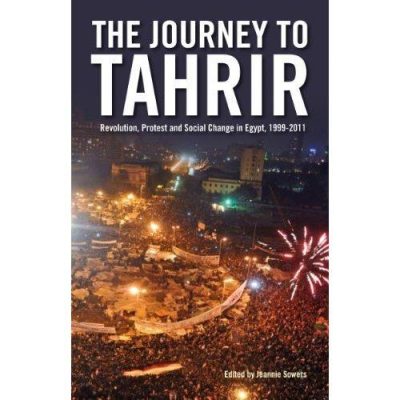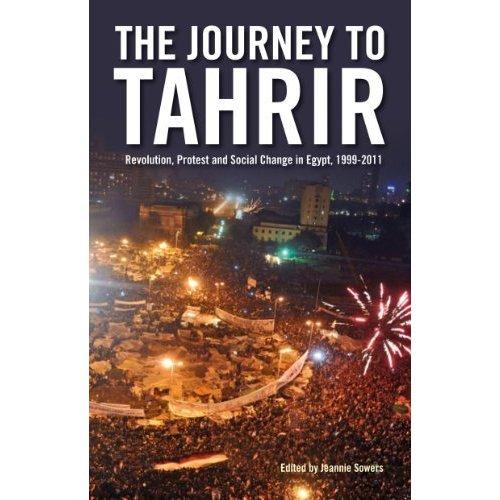 The essays in The Journey to Tahrir: Revolution, Protest and Social Change in Egypt, 1999-2011 validate Hannah Arendt’s famous quote that “revolutionaries do not make revolutions. The revolutionaries are those who know when power is lying in the street and then they can pick it up.” The Journey to Tahrir, edited by Jeannie Sowers, rejects the mainstream media’s often monolithic and melodramatic portrait of a random pro-democracy uprising in Egypt. Instead the contributors meticulously dissect the numerous components that coalesced in November 2011 in a mass social upheaval that brought down the Mubarak regime. Sowers and the other authors of The Journey to Tahrir make an important contribution to understanding the political situation in Egypt through their careful and comprehensive analysis of the revolution’s underpinnings and eccentricities.
The essays in The Journey to Tahrir: Revolution, Protest and Social Change in Egypt, 1999-2011 validate Hannah Arendt’s famous quote that “revolutionaries do not make revolutions. The revolutionaries are those who know when power is lying in the street and then they can pick it up.” The Journey to Tahrir, edited by Jeannie Sowers, rejects the mainstream media’s often monolithic and melodramatic portrait of a random pro-democracy uprising in Egypt. Instead the contributors meticulously dissect the numerous components that coalesced in November 2011 in a mass social upheaval that brought down the Mubarak regime. Sowers and the other authors of The Journey to Tahrir make an important contribution to understanding the political situation in Egypt through their careful and comprehensive analysis of the revolution’s underpinnings and eccentricities.
Despite the extensive media coverage of the 18 days of protest that ousted Mubarak, The Journey to Tahrir provides a fresh analysis that includes nuances only first-hand observers can provide. The unique character and historical experience that Egyptians brought to the collective actions – along with the social media tools and the careful selection of public venues – enabled citizens to effectively resist Mubarak’s methods of repression, particularly the security forces and hired thugs. The book also makes normative claims about the character of the Egyptian revolution. Political science professor Mona El-Ghobashy writes, “The genius of the Egyptian revolution is its methodical restoration of the public weal. The uprising restored the meaning of politics, if by that term is understood the making of collective claims on the government.”
The Journey to Tahrir also looks at the anti-war movement, the pro-labor activists, and the political opposition parties that laid the groundwork for the events of the Egyptian uprising. The protests, in other words, did not emerge from thin air. The anti-war protests of 2003, for instance, brought together leftists, young liberals, and Islamists to express discontent with Mubarak’s support of American foreign policy. As “anger grew at images of Iraqi casualties,” observes journalist Paul Schemm, “street politics threatened to take over Cairo on subsequent occasions.” Less than a decade later, Egyptians were able to focus their anger closer to home.
Discussing the prospect of economic reform, the book’s authors contend that a new model must emerge that represents what economist Karen Pfeifer calls “fourth stage- entailing at least the erosion of neoliberalism and perhaps, the beginning of an era of more balanced growth with a more equitable distribution of benefits.” Perhaps the book’s most controversial aspect is its inclusion of gender in the discussion of reforms and political movements in post-Mubarak Egypt. Looking at the normative role of women, veiling, marriage, and LGBTQ citizens, the book’s various authors suggest that the repressive regimes and norms of the past are in the process of a gradual restructuring. Social anthropologist Linda Herrera shows how contemporary veiling styles have become less orthodox and now represent the many stylistic preferences of Egypt’s less conservative youth.
The Journey to Tahrir most importantly focuses on the notion of collective action and popular democracy and draws attention to the hierarchical and non-inclusive structures of previous opposition and reform movements in Egypt. Optimistically, Sowers and the other authors make the case that the “January 25 Revolution has thus already shaped the political landscape of Egypt in new and profound ways. The significant gains made by the protestors, and their tenacity in returning to the streets, open up possibilities for systemic institutional transformation in the months and years to come. Success in creating a more accountable, inclusionary political system is far from assured. But for those who took to the streets…the uprising has already wrought substantial changes. These can be summed up as the dissolution of fear and its replacement with the willingness to challenge practices of political control and hierarchy.”
The book’s contributors give unique character and history to the movement through lived experience, with asides about protestors taking out trash as a symbolic action to reclaim public space and stories about street artists working alongside protestors. The Journey to Tahrir offers a deep and meaningful portrait of the revolution that shocked the world.
